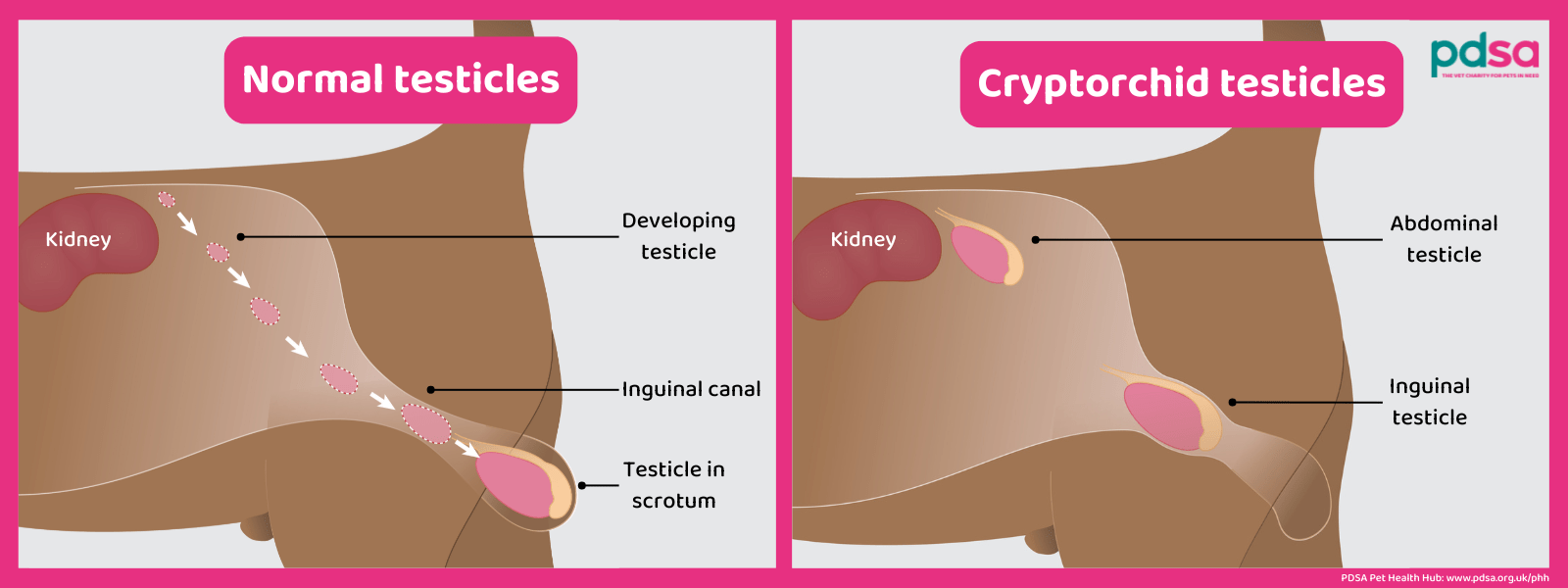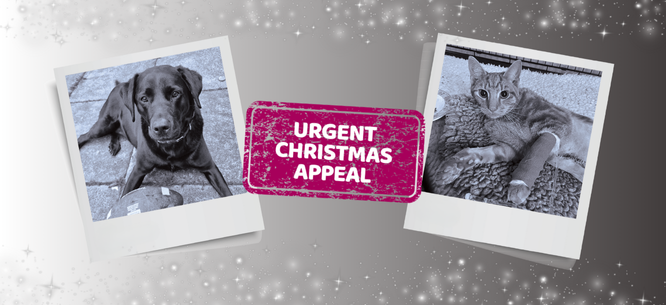Cryptorchidism / undescended testicles in dogs
Overview
- What is cryptorchidism? Cryptorchidism is when one or both testicles fail to drop into the scrotum after birth.
- What causes cryptorchidism? Cryptorchidism is a hereditary/genetic condition, meaning it’s passed from parent to puppy in their DNA.
- Why are cryptorchid testicles a problem? Cryptorchid testicles can become cancerous and/or twisted inside the abdomen – both of which can be life threatening.
- Treatment for cryptorchidism: If one or both of your dog’s testicles haven’t appeared by the time they are six months old it’s best to have them removed

Cryptorchidism is when one or both testicles fail to drop into the scrotum after birth. When a puppy is born, their testicles are still inside their body. Then, over the first one to two months of life, they slowly move into the scrotum via a narrow channel called the ‘inguinal canal’.
The process can take a little longer in some dogs, but if both testicles haven’t dropped by the time they are six months old it’s very unlikely that they will drop at all. Retained testicles can sit in the abdomen, or in the inguinal canal (see image above), and are a problem because they can become cancerous and/or twist, both of which can be life-threatening. Cryptorchid dogs have about a 13x higher risk of developing testicular cancer than normal dogs.
What causes cryptorchidism?
Cryptorchidism is a hereditary (genetic/inherited) condition, meaning it’s passed in DNA from parents to puppies. Certain breeds such as Chihuahuas, Poodles, Pomeranians, and Siberian Huskies are more prone to being cryptorchid.
Treatment
It’s important to have retained testicles removed to avoid the risk of them becoming cancerous and/or developing a torsion (becoming twisted).
The exact operation your dog needs depends on where the retained testicle(s) are. If they’re in the abdomen, your vet will need to make an incision along your dog’s tummy to open him up and find them – similar to spaying a female dog. If they are in the inguinal canal your vet may be able to remove them through an incision in your dog’s groin. Removing retained testicles usually takes slightly longer than a normal castration because it’s a more complex surgery, especially if they are difficult to find.
If your dog has one retained testicle and one normal testicle, it’s sensible to have both removed at the same time – the retained one to prevent a torsion or cancer, and the normal one to eliminate the risk of them breeding and passing the problem onto future generations. If you don’t want to have your dog fully castrated at the point, they need their retained testicle removed, it’s possible to delay removing their normal testicle until a later date. For example, some breeds benefit from having their neutering delayed until they are fully grown as sex hormones like testosterone have an effect on bone and muscle development. It’s best to discuss this with your vet so they can advise you on the potential risks and benefits of performing two separate procedures.
Recovery and aftercare
As with any surgery, your dog will need to be monitored closely during their recovery.
- Pain relief: It’s likely your dog will be sent home with anti-inflammatory pain medication for you to give them.
- Rest: Your dog may be sleepy and disoriented for a few hours after the surgery. They should start feeling better within 24-48 hours. You’ll need to limit their activity for seven to ten days to prevent complications with the wound. That means keeping them on a lead or possibly confining them to one room or a crate. Once your dog has recovered you can start gradually returning them to exercise.
- Wound protection: A protective cone is the most effective way to stop your dog licking or biting their wound. While a bodysuit can also be used, some dogs will try to lick or nibble themselves through the material so it’s important to keep an eye on them and have a cone to hand if needed.
- Follow-up check-ups: You may need to schedule a check-up with your vet a few days after the surgery, especially if there’s a problem with the surgical site.
- Stitch removal: Dissolvable stitches don't need removal. Non-dissolvable stitches will need to be removed 7-14 days after surgery.
If you have any concerns during your dog's recovery, don't hesitate to contact your vet.
 Video found at youtu.be/qfH2ajHDs6Q
Video found at youtu.be/qfH2ajHDs6Q
How to check whether your dog is cryptorchid
We expect all male puppies to have both testicles in their scrotum by the time they are six months old (often earlier). To check whether your dog/puppy is cryptorchid or not, simply gently feel their scrotum. Unless they have been castrated, you should be able to feel two round testicles that move freely within the sac. If you can't find both testicles, consult your vet.
Cost
It tends to cost more to castrate a cryptorchid dog than it does to do a regular castration because the operation is more complex and takes longer.
When you welcome a new dog into your life, consider getting dog insurance straight away before any signs of a problem start. This will give you peace of mind that you have some financial support if they ever get sick or injured.
- Can dogs breed with one testicle?
- Can a dog be born with only one testicle?
- Can my dog have an operation to get the retained testicle into the scrotum?
- Is there any treatment that could encourage a testicle to descend?
Can dogs breed with one testicle?
Yes, male dogs only need one working testicle to be fertile, but we strongly recommend against breeding from a cryptorchid dog because it’s a hereditary condition which is likely to pass onto future generations.
Can a dog be born with only one testicle?
Having only one testicle (monorchidism) is extremely rare in dogs. If your dog only has one obvious testicle, it’s more than likely that they’re cryptorchid (one testicle has failed to drop).
Can my dog have an operation to get the retained testicle into the scrotum?
Surgery to move a retained testicle into the scrotum is not recommended. The operation is rarely performed, as it doesn’t appear to reduce the risk of the testicle becoming cancerous, so has no benefit for the dog. The operation is also very complicated and carries a risk of serious damage to other structures such as the urinary system.
Is there any treatment that could encourage a testicle to descend?
Currently, there are no known treatments that reliably help a retained testicle move into the scrotum. Certain hormonal treatments have been tried, but they aren't very successful and can have negative side effects, such as affecting the development of bones and joints in young pets. Therefore, they aren't recommended.
Published: September 2024
Did you find this page useful?
Tell us more
Please note, our vets and nurses are unable to respond to questions via this form. If you are concerned about your pet’s health, please contact your vet directly.
Thank you for your feedback
Want to hear more about PDSA and get pet care tips from our vet experts?
Sign up to our e-newsletter
Written by vets and vet nurses. This advice is for UK pets only. Illustrations by Samantha Elmhurst.

